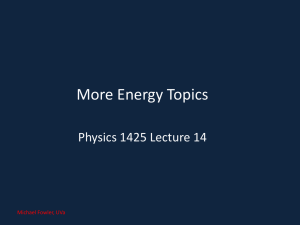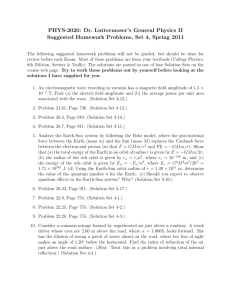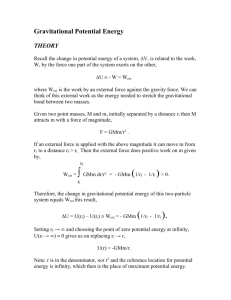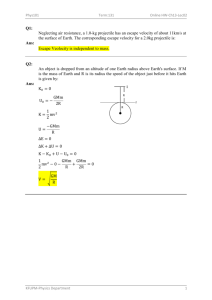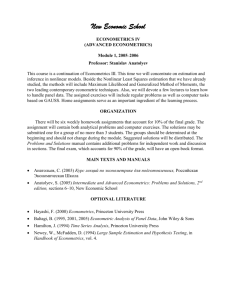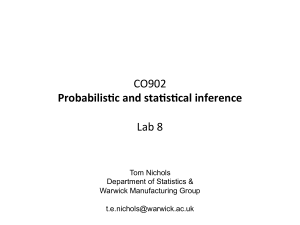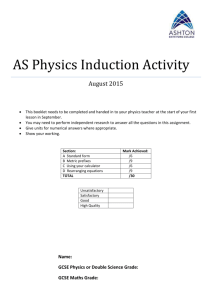Test--Astronomy and Optics Answers
advertisement
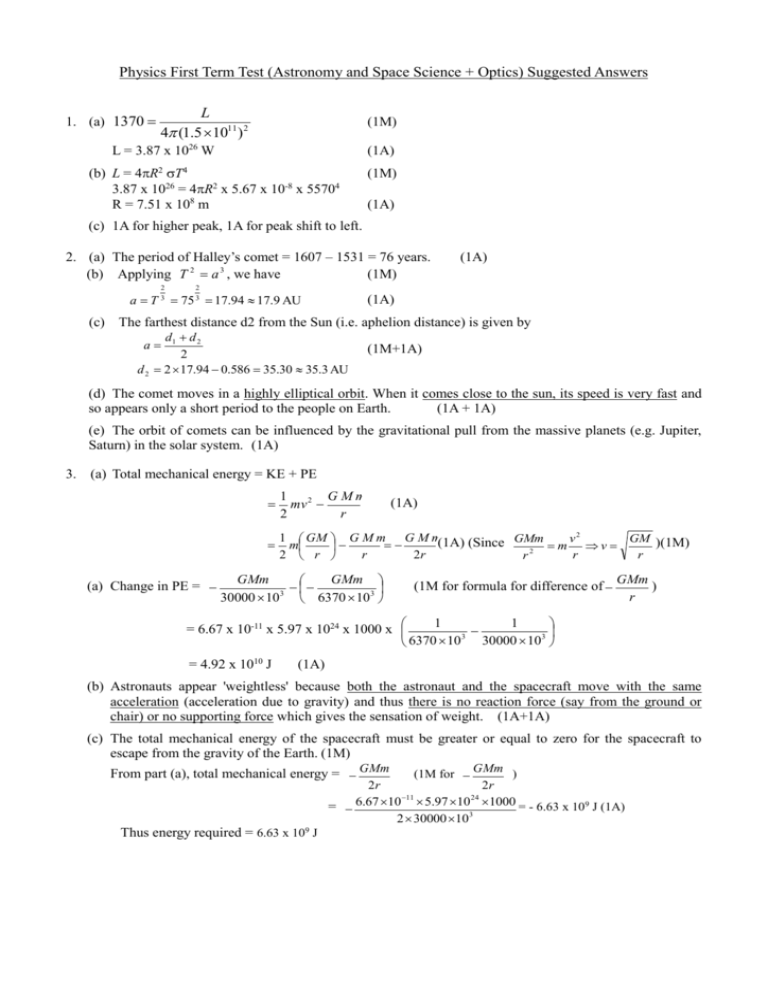
Physics First Term Test (Astronomy and Space Science + Optics) Suggested Answers 1. (a) 1370 L 4 (1.5 1011 ) 2 (1M) L = 3.87 x 1026 W (1A) (b) L = 4R2 T4 3.87 x 1026 = 4R2 x 5.67 x 10-8 x 55704 R = 7.51 x 108 m (1M) (1A) (c) 1A for higher peak, 1A for peak shift to left. 2. (a) The period of Halley’s comet = 1607 – 1531 = 76 years. (b) Applying T 2 a 3 , we have (1M) 2 (1A) 2 a T 3 75 3 17.94 17.9 AU (1A) (c) The farthest distance d2 from the Sun (i.e. aphelion distance) is given by d1 d 2 2 d 2 2 17.94 0.586 35.30 35.3 AU a (1M+1A) (d) The comet moves in a highly elliptical orbit. When it comes close to the sun, its speed is very fast and so appears only a short period to the people on Earth. (1A + 1A) (e) The orbit of comets can be influenced by the gravitational pull from the massive planets (e.g. Jupiter, Saturn) in the solar system. (1A) 3. (a) Total mechanical energy = KE + PE (a) Change in PE = 1 2 GMm mv 2 r 1 GM G M m G M m(1A) (Since GMm v2 GM )(1M) m m v 2 2 r r 2r r r r GMm GMm 3 30000 10 6370 103 (1A) (1M for formula for difference of GMm ) r 1 1 = 6.67 x 10-11 x 5.97 x 1024 x 1000 x 3 30000 103 6370 10 = 4.92 x 1010 J (1A) (b) Astronauts appear 'weightless' because both the astronaut and the spacecraft move with the same acceleration (acceleration due to gravity) and thus there is no reaction force (say from the ground or chair) or no supporting force which gives the sensation of weight. (1A+1A) (c) The total mechanical energy of the spacecraft must be greater or equal to zero for the spacecraft to escape from the gravity of the Earth. (1M) From part (a), total mechanical energy = GMm (1M for GMm ) 2r 2r 11 24 6 . 67 10 5 . 97 10 1000 = - 6.63 x 109 J (1A) = 3 2 30000 10 Thus energy required = 6.63 x 109 J 4. (a) L LSUN R2 T 4 2 4 RSUN TSUN (1M) 24004 LSUN 57774 L = 2.69 x 104 LSUN L 9502 (1A) (b) The absolute magnitude of a star is the apparent magnitude of the star when it were placed at 10 pc from Earth. (1A+1A) (c) (i) m – M = 5 log d/10 0.4 - (-6.0) = 5 log d/10 d = 190.5 pc (1M) (1A) (ii) 1.6 – (-2.7) = 5 log d/10 d = 72.4 pc (1A) (d) apparent brightness of Bellatrix 2.512(1.6 0.4 ) 3.02 apparent brightness of Betelgeus e 5. (a) v c 9.7 10 3 3 108 2.91 106 m / s (1M+1A) (1M+1A) (b) R = vt = 2.91 x 106 x 365 x 24 x 3600 = 9.177 x 1013 m = 9.177 x 1013 / 9.46 1015 m = 9.701 x 10-3 ly (1M+1A) 3 (c) d R 9.701 10 (1M for correct d +1A) 7146ly 0.28 1 3600 180 6. (a) The object is far away from the lens because the incident rays shown are parallel. (b) [1A+1A] Incident rays parallel to principal axis, converge to focus A [1A+1A] (c) A camera or telescope [1A] (d) The image formed by a concave lens is virtual, erect and on the same side as object while that formed by a convex lens is real, inverted and on opposite side of the lens. [1A+1A] (e) (1A for diverging from focus, 1A for 2 correct rays) MC 1-5 B D C A D 6-10 ACADB 11-15 B B A D A 16-20 D B C C B Explanations to selected mc 4. Statement 2, the moon orbits around the Earth in Ptolemaic model. 10. Loss in PE = gain in KE GMm GMm 1 2 ( ) mv 2r r 2 13. max is inversely proportional to T. 19. n sin i sin r sin 600 7.5 102 7.52 1.44
